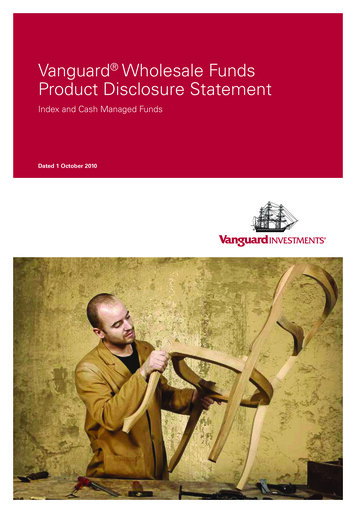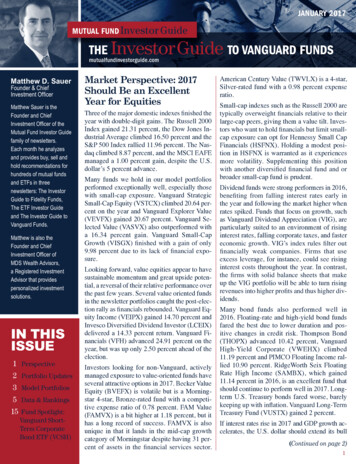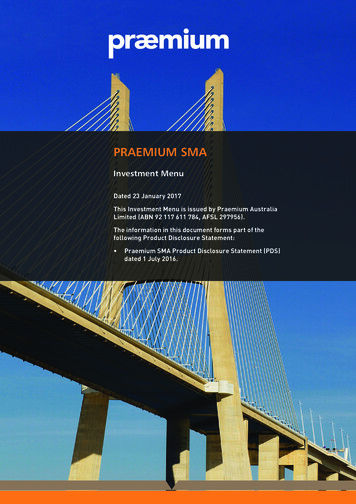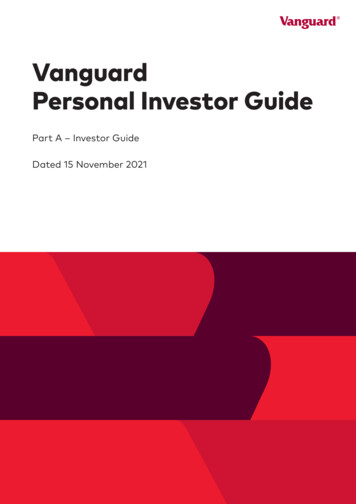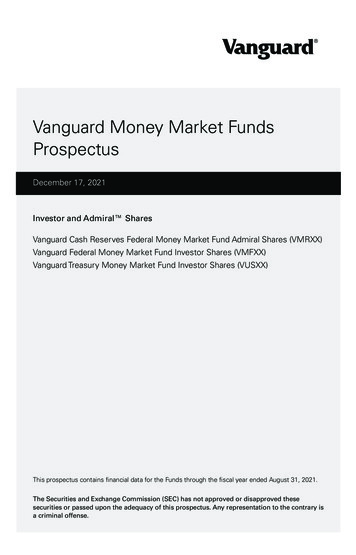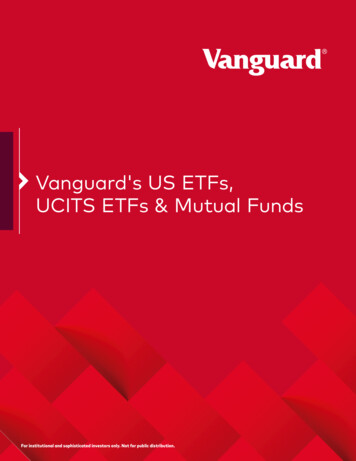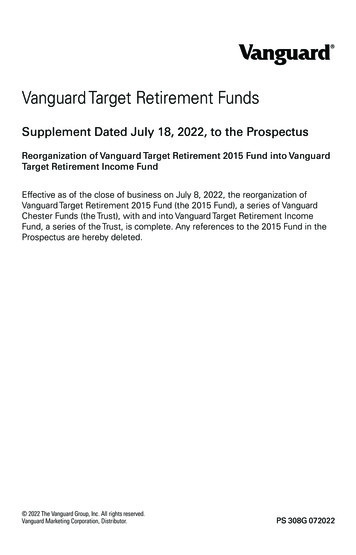
Transcription
Vanguard Target Retirement FundsSupplement Dated July 18, 2022, to the ProspectusReorganization of Vanguard Target Retirement 2015 Fund into VanguardTarget Retirement Income FundEffective as of the close of business on July 8, 2022, the reorganization ofVanguard Target Retirement 2015 Fund (the 2015 Fund), a series of VanguardChester Funds (the Trust), with and into Vanguard Target Retirement IncomeFund, a series of the Trust, is complete. Any references to the 2015 Fund in theProspectus are hereby deleted. 2022 The Vanguard Group, Inc. All rights reserved.Vanguard Marketing Corporation, Distributor.PS 308G 072022
Vanguard Target Retirement FundsProspectusJanuary 31, 2022Investor SharesVanguard Target Retirement Income Fund Investor Shares (VTINX)Vanguard Target Retirement 2015 Fund Investor Shares (VTXVX)Vanguard Target Retirement 2020 Fund Investor Shares (VTWNX)Vanguard Target Retirement 2025 Fund Investor Shares (VTTVX)Vanguard Target Retirement 2030 Fund Investor Shares (VTHRX)Vanguard Target Retirement 2035 Fund Investor Shares (VTTHX)Vanguard Target Retirement 2040 Fund Investor Shares (VFORX)Vanguard Target Retirement 2045 Fund Investor Shares (VTIVX)Vanguard Target Retirement 2050 Fund Investor Shares (VFIFX)Vanguard Target Retirement 2055 Fund Investor Shares (VFFVX)Vanguard Target Retirement 2060 Fund Investor Shares (VTTSX)Vanguard Target Retirement 2065 Fund Investor Shares (VLXVX)This prospectus contains financial data for the Funds through the fiscal year endedSeptember 30, 2021.The Securities and Exchange Commission (SEC) has not approved or disapproved thesesecurities or passed upon the adequacy of this prospectus. Any representation to the contrary isa criminal offense.
ContentsFund SummariesMore on the Funds76Vanguard Target Retirement Income Fund1The Funds and Vanguard87Vanguard Target Retirement 2015 Fund7Investment Advisor88Vanguard Target Retirement 2020 Fund13Dividends, Capital Gains, and Taxes89Vanguard Target Retirement 2025 Fund19Share Price92Vanguard Target Retirement 2030 Fund25 Financial HighlightsVanguard Target Retirement 2035 Fund31 Investing With Vanguard105Vanguard Target Retirement 2040 Fund37Purchasing Shares105Vanguard Target Retirement 2045 Fund43Redeeming Shares108Vanguard Target Retirement 2050 Fund49Exchanging Shares112Vanguard Target Retirement 2055 Fund55Frequent-Trading Limitations112Vanguard Target Retirement 2060 Fund61Other Rules You Should Know115Vanguard Target Retirement 2065 Fund68Fund and Account Updates11974Employer-Sponsored Plans120Contacting Vanguard122Additional Information122Investing in Vanguard Target Retirement FundsGlossary of Investment Terms93126
Vanguard Target Retirement Income FundInvestment ObjectiveThe Fund seeks to provide current income and some capital appreciation.Fees and ExpensesThe following table describes the fees and expenses you may pay if you buy,hold, and sell shares of the Fund. You may pay other fees, such as brokeragecommissions and other fees to financial intermediaries, which are not reflectedin the table and example below.Shareholder Fees(Fees paid directly from your investment)Sales Charge (Load) Imposed on PurchasesPurchase FeeNoneNoneSales Charge (Load) Imposed on Reinvested DividendsRedemption FeeNoneNoneAccount Service Fee Per Year(for certain fund account balances below 10,000) 20Annual Fund Operating Expenses(Expenses that you pay each year as a percentage of the value of your investment)Management Fees0.00%12b-1 Distribution FeeOther ExpensesAcquired Fund Fees and ExpensesNone0.00%0.12%Total Annual Fund Operating Expenses0.12%1
ExampleThe following example is intended to help you compare the cost of investing inthe Fund (based on the fees and expenses of the acquired funds) with the costof investing in other mutual funds. It illustrates the hypothetical expenses thatyou would incur over various periods if you were to invest 10,000 in the Fund’sshares. This example assumes that the Fund provides a return of 5% each yearand that total annual fund operating expenses (of the Fund and its underlyingfunds) remain as stated in the preceding table. You would incur thesehypothetical expenses whether or not you were to redeem your investment atthe end of the given period. Although your actual costs may be higher or lower,based on these assumptions your costs would be:1 Year 123 Years 395 Years 6810 Years 154Portfolio TurnoverThe Fund may pay transaction costs, such as purchase fees, when it buys andsells securities (or “turns over” its portfolio). A higher portfolio turnover rate mayindicate higher transaction costs and may result in more taxes when Fundshares are held in a taxable account. These costs, which are not reflected inannual fund operating expenses or in the previous expense example, reduce theFund’s performance. During the most recent fiscal year, the Fund’s portfolioturnover rate was 6% of the average value of its portfolio.Principal Investment StrategiesThe Fund invests in a mix of Vanguard mutual funds (underlying funds) accordingto an asset allocation strategy designed for investors currently in retirement. Asof September 30, 2021, the Fund’s allocation among the underlying assetclasses was as follows: U.S. fixed-income securitiesU.S. stocksInflation-indexed securitiesForeign fixed-income securitiesForeign stocks37.4%17.3%17.1%16.3%11.9%At any given time, the Fund’s asset allocation may be affected by a variety offactors, such as whether the underlying funds are accepting additionalinvestments.The Fund’s indirect fixed-income holdings are a diversified mix of short-,intermediate-, and long-term U.S. government, U.S. agency, andinvestment-grade U.S. corporate bonds; inflation-protected public obligations2
issued by the U.S. Treasury; mortgage-backed and asset-backed securities; andgovernment, agency, corporate, and securitized investment-grade foreign bondsissued in currencies other than the U.S. dollar (but hedged by Vanguard tominimize foreign currency exposure).The Fund’s indirect stock holdings are a diversified mix of U.S. and foreign large-,mid-, and small-capitalization stocks.Principal RisksThe Fund is subject to the risks associated with the stock and bond markets, anyof which could cause an investor to lose money, and the level of risk may varybased on market conditions. An investment in the Fund is not guaranteed. Aninvestor may experience losses. There is no guarantee that the Fund will provideadequate income through retirement. Because bonds and short-terminvestments are typically less volatile than stocks and because the Fund investsmost of its assets in bonds and short-term investments, the Fund’s overall levelof risk is expected to be low to moderate. With approximately 70% of its assets allocated to fixed-income securities, theFund is proportionately subject to the following bond risks: interest rate risk,which is the chance that bond prices overall will decline because of risinginterest rates; income risk, which is the chance that an underlying fund’s incomewill decline because of falling interest rates; credit risk, which is the chance thata bond issuer will fail to pay interest or principal in a timely manner or thatnegative perceptions of the issuer’s ability to make such payments will cause theprice of that bond to decline, thus reducing the underlying fund’s return; and callrisk, which is the chance that during periods of falling interest rates, issuers ofcallable bonds may call (redeem) securities with higher coupon rates or interestrates before their maturity dates. An underlying fund would then lose any priceappreciation above the bond’s call price and would be forced to reinvest theunanticipated proceeds at lower interest rates, resulting in a decline in theunderlying fund’s income. The Fund is also subject to the following risksassociated with investments in currency-hedged foreign bonds: country/regionalrisk, which is the chance that world events—such as political upheaval, financialtroubles, or natural disasters—will adversely affect the value and/or liquidity ofsecurities issued by foreign governments, government agencies, or companies;and currency hedging risk, which is the chance that the currency hedgingtransactions entered into by the underlying foreign fixed-income securities fundsmay not perfectly offset the fund’s foreign currency exposure. With approximately 30% of its assets allocated to stocks, the Fund isproportionately subject to stock market risk, which is the chance that stockprices overall will decline. Stock markets tend to move in cycles, with periods ofrising prices and periods of falling prices. The Fund is also subject to thefollowing risks associated with investments in foreign stocks: country/regionalrisk, which is the chance that world events—such as political upheaval, financialtroubles, or natural disasters—will adversely affect the value of securities issuedby companies in foreign countries or regions; and currency risk, which is thechance that the value of a foreign investment, measured in U.S. dollars, will3
decrease because of unfavorable changes in currency exchange rates.Country/regional risk and currency risk are especially high in emerging markets. The Fund is also subject to asset allocation risk, which is the chance that theselection of underlying funds, and the allocation of assets to them, will causethe Fund to underperform other funds with a similar investment objective.An investment in the Fund is not a deposit of a bank and is not insured orguaranteed by the Federal Deposit Insurance Corporation or any othergovernment agency.Annual Total ReturnsThe following bar chart and table are intended to help you understand the risksof investing in the Fund. The bar chart shows how the performance of the Fundhas varied from one calendar year to another over the periods shown. The tableshows how the average annual total returns of the Fund compare with those ofrelevant market indexes and a composite stock/bond index, which haveinvestment characteristics similar to those of the Fund. The Target RetirementIncome Composite Index is a custom blended index developed by Vanguardbased on the Fund’s asset allocation glide schedule, which becomes moreconservative as time elapses. As of September 30, 2021, the composite wasderived using the following portion allocations: 12% FTSE Global All Cap ex USIndex; 37.2% Bloomberg U.S. Aggregate Float Adjusted Index; 16.8%Bloomberg U.S. Treasury Inflation-Protected Securities (TIPS) 0-5 Year Index;16% Bloomberg Global Aggregate ex-USD Float Adjusted RIC Capped Index(USD Hedged); and 18% CRSP US Total Market Index. International stockbenchmark returns are adjusted for withholding taxes. The components thatmake up the composite index may vary over time. Percentages listed may nottotal to 100% due to rounding. Keep in mind that the Fund’s past performance(before and after taxes) does not indicate how the Fund will perform in thefuture. Updated performance information is available on our website atvanguard.com/performance or by calling Vanguard toll-free at 800-662-7447.4
Annual Total Returns — Vanguard Target Retirement Income Fund Investor –1.99-5%During the periods shown in the bar chart, the highest and lowest returns for acalendar quarter were:HighestLowestTotal Return7.84%-5.91%QuarterJune 30, 2020March 31, 2020Average Annual Total Returns for Periods Ended December 31, 20211 Year5 Years10 YearsVanguard Target Retirement Income Fund Investor SharesReturn Before TaxesReturn After Taxes on Distributions5.25%2.896.85%5.485.88%4.74Return After Taxes on Distributions and Sale of Fund SharesTarget Retirement Income Composite Index(reflects no deduction for fees, expenses, or taxes)Bloomberg U.S. Aggregate Bond Index(reflects no deduction for fees, expenses, or taxes)4.194.964.305.44%7.12%6.10%-1.543.572.90MSCI US Broad Market Index(reflects no deduction for fees, expenses, or taxes)26.1018.0916.39Actual after-tax returns depend on your tax situation and may differ from thoseshown in the preceding table. When after-tax returns are calculated, it isassumed that the shareholder was in the highest individual federal marginalincome tax bracket at the time of each distribution of income or capital gains orupon redemption. State and local income taxes are not reflected in thecalculations. Please note that after-tax returns are not relevant for a shareholderwho holds fund shares in a tax-deferred account, such as an individual retirementaccount or a 401(k) plan. Also, figures captioned Return After Taxes onDistributions and Sale of Fund Shares may be higher than other figures for thesame period if a capital loss occurs upon redemption and results in an assumedtax deduction for the shareholder.Investment AdvisorThe Vanguard Group, Inc. (Vanguard)5
Portfolio ManagersWilliam A. Coleman, CFA, Portfolio Manager at Vanguard. He has co-managedthe Fund since 2013.Walter Nejman, Portfolio Manager at Vanguard. He has co-managed the Fundsince 2013.Purchase and Sale of Fund SharesYou may purchase or redeem shares online through our website (vanguard.com),by mail (The Vanguard Group, P.O. Box 982901, El Paso, TX 79998-2901), or bytelephone (800-662-2739). The minimum investment amount required to openand maintain a Fund account for Investor Shares is 1,000. The minimuminvestment amount required to add to an existing Fund account is generally 1.Financial intermediaries, institutional clients, and Vanguard-advised clients shouldcontact Vanguard for information on special eligibility rules that may apply tothem regarding Investor Shares. If you are investing through an intermediary,please contact that firm directly for more information regarding your eligibility. Ifyou are investing through an employer-sponsored retirement or savings plan,your plan administrator or your benefits office can provide you with detailedinformation on how you can invest through your plan.Tax InformationThe Fund’s distributions may be taxable as ordinary income or capital gain. If youare investing through a tax-advantaged account, such as an IRA or anemployer-sponsored retirement or savings plan, special tax rules apply.Payments to Financial IntermediariesThe Fund and its investment advisor do not pay financial intermediaries for salesof Fund shares.6
Vanguard Target Retirement 2015 FundInvestment ObjectiveThe Fund seeks to provide capital appreciation and current income consistentwith its current asset allocation.Fees and ExpensesThe following table describes the fees and expenses you may pay if you buy,hold, and sell shares of the Fund. You may pay other fees, such as brokeragecommissions and other fees to financial intermediaries, which are not reflectedin the table and example below.Shareholder Fees(Fees paid directly from your investment)Sales Charge (Load) Imposed on PurchasesPurchase FeeNoneNoneSales Charge (Load) Imposed on Reinvested DividendsRedemption FeeNoneNoneAccount Service Fee Per Year(for certain fund account balances below 10,000) 20Annual Fund Operating Expenses(Expenses that you pay each year as a percentage of the value of your investment)Management Fees0.00%12b-1 Distribution FeeOther ExpensesAcquired Fund Fees and ExpensesNone0.00%0.12%Total Annual Fund Operating Expenses0.12%7
ExampleThe following example is intended to help you compare the cost of investing inthe Fund (based on the fees and expenses of the acquired funds) with the costof investing in other mutual funds. It illustrates the hypothetical expenses thatyou would incur over various periods if you were to invest 10,000 in the Fund’sshares. This example assumes that the Fund provides a return of 5% each yearand that total annual fund operating expenses (of the Fund and its underlyingfunds) remain as stated in the preceding table. You would incur thesehypothetical expenses whether or not you were to redeem your investment atthe end of the given period. Although your actual costs may be higher or lower,based on these assumptions your costs would be:1 Year 123 Years 395 Years 6810 Years 154Portfolio TurnoverThe Fund may pay transaction costs, such as purchase fees, when it buys andsells securities (or “turns over” its portfolio). A higher portfolio turnover rate mayindicate higher transaction costs and may result in more taxes when Fundshares are held in a taxable account. These costs, which are not reflected inannual fund operating expenses or in the previous expense example, reduce theFund’s performance. During the most recent fiscal year, the Fund’s portfolioturnover rate was 4% of the average value of its portfolio.Principal Investment StrategiesThe Fund invests in a mix of Vanguard mutual funds (underlying funds) accordingto an asset allocation strategy designed for investors planning to retire and leavethe workforce in or within a few years of 2015 (the target year). The Fund isdesigned for an investor who plans to withdraw the value of an account in theFund over a period of many years after the target year. The Fund’s assetallocation will become more conservative over time, meaning that thepercentage of assets allocated to stocks will decrease while the percentage ofassets allocated to bonds and other fixed income investments will increase.Within seven years after 2015, the Fund’s asset allocation should become similarto that of the Target Retirement Income Fund. As of September 30, 2021, theFund’s allocation among the underlying asset classes was as follows: 8U.S. fixed-income securitiesU.S. stocksInflation-indexed securitiesForeign fixed-income securitiesForeign stocks36.5%18.7%16.2%15.8%12.8%
At any given time, the Fund’s asset allocation may be affected by a variety offactors, such as whether the underlying funds are accepting additionalinvestments.The Fund’s indirect fixed-income holdings are a diversified mix of short-,intermediate-, and long-term U.S. government, U.S. agency, andinvestment-grade U.S. corporate bonds; inflation-protected public obligationsissued by the U.S. Treasury; mortgage-backed and asset-backed securities; andgovernment, agency, corporate, and securitized investment-grade foreign bondsissued in currencies other than the U.S. dollar (but hedged by Vanguard tominimize foreign currency exposure).The Fund’s indirect stock holdings are a diversified mix of U.S. and foreign large-,mid-, and small-capitalization stocks.Principal RisksThe Fund is subject to the risks associated with the stock and bond markets, anyof which could cause an investor to lose money, and the level of risk may varybased on market conditions. An investment in the Fund is not guaranteed. Aninvestor may experience losses, including losses near, at, or after the target year.There is no guarantee that the Fund will provide adequate income at or after thetarget year. Because fixed income securities such as bonds are typically lessvolatile than stocks and because the Fund currently invests a significant portionof its assets in fixed income securities, the Fund’s overall level of risk is expectedto be lower than that of funds investing entirely in stocks. With approximately 70% of its assets allocated to fixed-income securities, theFund is proportionately subject to the following bond risks: interest rate risk,which is the chance that bond prices overall will decline because of risinginterest rates; income risk, which is the chance that an underlying fund’s incomewill decline because of falling interest rates; credit risk, which is the chance thata bond issuer will fail to pay interest or principal in a timely manner or thatnegative perceptions of the issuer’s ability to make such payments will cause theprice of that bond to decline, thus reducing the underlying fund’s return; and callrisk, which is the chance that during periods of falling interest rates, issuers ofcallable bonds may call (redeem) securities with higher coupon rates or interestrates before their maturity dates. An underlying fund would then lose any priceappreciation above the bond’s call price and would be forced to reinvest theunanticipated proceeds at lower interest rates, resulting in a decline in theunderlying fund’s income. The Fund is also subject to the following risksassociated with investments in currency-hedged foreign bonds: country/regionalrisk, which is the chance that world events—such as political upheaval, financialtroubles, or natural disasters—will adversely affect the value and/or liquidity ofsecurities issued by foreign governments, government agencies, or companies;and currency hedging risk, which is the chance that the currency hedging9
transactions entered into by the underlying foreign fixed-income securities fundsmay not perfectly offset the fund’s foreign currency exposure. With approximately 30% of its assets allocated to stocks, the Fund isproportionately subject to stock market risk, which is the chance that stockprices overall will decline. Stock markets tend to move in cycles, with periods ofrising prices and periods of falling prices. The Fund is also subject to thefollowing risks associated with investments in foreign stocks: country/regionalrisk, which is the chance that world events—such as political upheaval, financialtroubles, or natural disasters—will adversely affect the value of securities issuedby companies in foreign countries or regions; and currency risk, which is thechance that the value of a foreign investment, measured in U.S. dollars, willdecrease because of unfavorable changes in currency exchange rates.Country/regional risk and currency risk are especially high in emerging markets. The Fund is also subject to asset allocation risk, which is the chance that theselection of underlying funds, and the allocation of assets to them, will causethe Fund to underperform other funds with a similar investment objective.An investment in the Fund is not a deposit of a bank and is not insured orguaranteed by the Federal Deposit Insurance Corporation or any othergovernment agency.Annual Total ReturnsThe following bar chart and table are intended to help you understand the risksof investing in the Fund. The bar chart shows how the performance of the Fundhas varied from one calendar year to another over the periods shown. The tableshows how the average annual total returns of the Fund compare with those ofrelevant market indexes and a composite stock/bond index, which haveinvestment characteristics similar to those of the Fund. The Target Retirement2015 Composite Index is a custom blended index developed by Vanguard basedon the Fund’s asset allocation glide schedule, which becomes more conservativeas time elapses. As of September 30, 2021, the composite was derived usingthe following portion allocations: 12.7% FTSE Global All Cap ex US Index; 36.6%Bloomberg U.S. Aggregate Float Adjusted Index; 16.1% Bloomberg U.S. TreasuryInflation-Protected Securities (TIPS) 0-5 Year Index; 15.7% Bloomberg GlobalAggregate ex-USD Float Adjusted RIC Capped Index (USD Hedged); and 19%CRSP US Total Market Index. International stock benchmark returns are adjustedfor withholding taxes. The components that make up the composite index mayvary over time. Percentages listed may not total to 100% due to rounding. Keepin mind that the Fund’s past performance (before and after taxes) does notindicate how the Fund will perform in the future. Updated performanceinformation is available on our website at vanguard.com/performance or bycalling Vanguard toll-free at 800-662-7447.10
Annual Total Returns — Vanguard Target Retirement 2015 Fund Investor ��0.46–2.97-10%During the periods shown in the bar chart, the highest and lowest returns for acalendar quarter were:HighestLowestTotal Return8.90%-7.44%QuarterJune 30, 2020March 31, 2020Average Annual Total Returns for Periods Ended December 31, 20211 Year5 Years10 YearsVanguard Target Retirement 2015 Fund Investor SharesReturn Before TaxesReturn After Taxes on Distributions5.78%2.407.71%5.647.46%5.89Return After Taxes on Distributions and Sale of Fund SharesTarget Retirement 2015 Composite Index(reflects no deduction for fees, expenses, or taxes)Bloomberg U.S. Aggregate Bond Index(reflects no deduction for fees, expenses, or taxes)5.305.635.625.96%7.97%7.70%-1.543.572.90MSCI US Broad Market Index(reflects no deduction for fees, expenses, or taxes)26.1018.0916.39Actual after-tax returns depend on your tax situation and may differ from thoseshown in the preceding table. When after-tax returns are calculated, it isassumed that the shareholder was in the highest individual federal marginalincome tax bracket at the time of each distribution of income or capital gains orupon redemption. State and local income taxes are not reflected in thecalculations. Please note that after-tax returns are not relevant for a shareholderwho holds fund shares in a tax-deferred account, such as an individual retirementaccount or a 401(k) plan. Also, figures captioned Return After Taxes onDistributions and Sale of Fund Shares may be higher than other figures for thesame period if a capital loss occurs upon redemption and results in an assumedtax deduction for the shareholder.11
Investment AdvisorThe Vanguard Group, Inc. (Vanguard)Portfolio ManagersWilliam A. Coleman, CFA, Portfolio Manager at Vanguard. He has co-managedthe Fund since 2013.Walter Nejman, Portfolio Manager at Vanguard. He has co-managed the Fundsince 2013.Purchase and Sale of Fund SharesYou may purchase or redeem shares online through our website (vanguard.com),by mail (The Vanguard Group, P.O. Box 982901, El Paso, TX 79998-2901), or bytelephone (800-662-2739). The minimum investment amount required to openand maintain a Fund account for Investor Shares is 1,000. The minimuminvestment amount required to add to an existing Fund account is generally 1.Financial intermediaries, institutional clients, and Vanguard-advised clients shouldcontact Vanguard for information on special eligibility rules that may apply tothem regarding Investor Shares. If you are investing through an intermediary,please contact that firm directly for more information regarding your eligibility. Ifyou are investing through an employer-sponsored retirement or savings plan,your plan administrator or your benefits office can provide you with detailedinformation on how you can invest through your plan.Tax InformationThe Fund’s distributions may be taxable as ordinary income or capital gain. If youare investing through a tax-advantaged account, such as an IRA or anemployer-sponsored retirement or savings plan, special tax rules apply.Payments to Financial IntermediariesThe Fund and its investment advisor do not pay financial intermediaries for salesof Fund shares.12
Vanguard Target Retirement 2020 FundInvestment ObjectiveThe Fund seeks to provide capital appreciation and current income consistentwith its current asset allocation.Fees and ExpensesThe following table describes the fees and expenses you may pay if you buy,hold, and sell shares of the Fund. You may pay other fees, such as brokeragecommissions and other fees to financial intermediaries, which are not reflectedin the table and example below.Shareholder Fees(Fees paid directly from your investment)Sales Charge (Load) Imposed on PurchasesPurchase FeeNoneNoneSales Charge (Load) Imposed on Reinvested DividendsRedemption FeeNoneNoneAccount Service Fee Per Year(for certain fund account balances below 10,000) 20Annual Fund Operating Expenses(Expenses that you pay each year as a percentage of the value of your investment)Management Fees0.00%12b-1 Distribution FeeOther ExpensesAcquired Fund Fees and ExpensesNone0.00%0.13%Total Annual Fund Operating Expenses0.13%13
ExampleThe following example is intended to help you compare the cost of investing inthe Fund (based on the fees and expenses of the acquired funds) with the costof investing in other mutual funds. It illustrates the hypothetical expenses thatyou would incur over various periods if you were to invest 10,000 in the Fund’sshares. This example assumes that the Fund provides a return of 5% each yearand that total annual fund operating expenses (of the Fund and its underlyingfunds) remain as stated in the preceding table. You would incur thesehypothetical expenses whether or not you were to redeem your investment atthe end of the given period. Although your actual costs may be higher or lower,based on these assumptions your costs would be:1 Year 133 Years 425 Years 7310 Years 166Portfolio TurnoverThe Fund may pay transaction costs, such as purchase fees, when it buys andsells securities (or “turns over” its portfolio). A higher portfolio turnover rate mayindicate higher transaction costs and may result in more taxes when Fundshares are held in a taxable account. These costs, which are not reflected inannual fund operating expenses or in the previous expense example, reduce theFund’s performance. During the most recent fiscal year, the Fund’s portfolioturnover rate was 5% of the average value of its portfolio.Principal Investment StrategiesThe Fund invests in a mix of Vanguard mutual funds (underlying funds) accordingto an asset allocation strategy designed for investors planning to retire and leavethe workforce in or within a few years of 2020 (the target year). The Fund isdesigned for an investor who plans to withdraw the value of an account in theFund over a period of many years after the target year. The Fund’s assetallocation will become more conservative over time, meaning that thepercentage of assets allocated to stocks will decrease while the percentage ofassets allocated to bonds and other fixed income investments will increase.Within seven years after 2020, the Fund’s asset allocation should become similarto that of the Target Retirement Income Fund. As of September 30, 2021,
VanguardTarget Retirement Income Fund Investor Shares (VTINX) VanguardTarget Retirement 2015 Fund Investor Shares (VTXVX) VanguardTarget Retirement 2020 Fund Investor Shares (VTWNX) . This prospectus contains financial data for the Funds through the fiscal year ended September 30, 2021. The Securities and Exchange Commission (SEC) has not .



